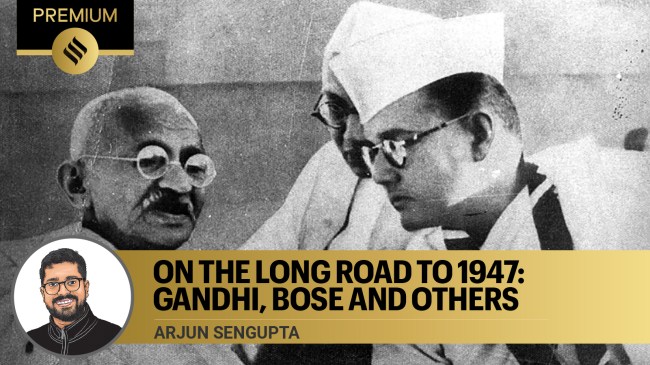Opinion History Headline | On the long journey to freedom: Gandhi, Bose and many others
As Bipan Chandra and the others wrote: “The British decision to transfer power was not merely a response to the immediate situation prevailing in the winter of 1945-46, but a result of their realisation that their legitimacy to rule had been irrevocably eroded over the years.”
 Mahatma Gandhi with Netaji Subhas Chandra Bose in 1938. (Express Archives)
Mahatma Gandhi with Netaji Subhas Chandra Bose in 1938. (Express Archives) Tamil Nadu Governor R N Ravi recently said that it was Subhash Chandra Bose, not the Indian National Congress or Mahatma Gandhi, who should be credited for compelling the British to leave India in 1947. However, the circumstances that marked that period suggest that a number of factors — from Britain’s fiscal position to growing nationalist sentiment — played a role in India’s journey towards Independence.
Congress’ “inaction” post Quit India
While saying the Congress and Mahatma Gandhi had a minimal impact on Britain’s eventual decision to grant India freedom, Governor Ravi cited the Congress’s “inaction” post-1942.
The period of “inaction”, however, coincided with the British moving to crush the Congress in response to the Quit India Movement that was launched on August 8, 1942. By August 9, the Congress’s entire leadership, including Nehru, Gandhi, and Vallabhai Patel, was arrested, effectively obliterating the party’s organisation.
This led to a surge of nationalist sentiment among the masses, who took to the streets with hartals, public demonstrations and processions.
“The Quit India Movement marked a new high in terms of popular participation in the national movement and sympathy with the national cause,” historian Bipan Chandra and others wrote in India’s Struggle for Independence (1989). But faced with brutal repression and effectively leaderless, the mass movement fizzled out within a few months.
Thus, till the end of World War 2 in 1945, when senior Congress leaders were finally released, the national movement had taken on a far more discreet form. Thus, while young Congress leaders organised themselves underground, a nationwide mass movement was out of the question.
However, the impact of the Quit India Movement in framing India’s nationalist discourse was nonetheless significant. As Chandra and the others wrote, “After ‘Quit India,’ there could be no retreat. Any future negotiations with the British Government could only be on the manner of the transfer of power.”
Furthermore, post-War, British excesses carried out during the Quit India Movement played a part in catalysing a national upsurge that would eventually culminate with 1947.
Bose’s INA and its impact
Governor Ravi, in his speech, credited Subhas Chandra Bose for “reigniting” the freedom struggle.
After spending all his political life in the Congress, Bose had a final falling out with its leadership over how to respond to World War II. While Nehru and Gandhi did not want to have any truck with the fascists, Bose was more open to allying with his enemy’s enemy.
After escaping from house arrest in Calcutta in January 1941, he travelled to Germany via Afghanistan and the USSR (German-occupied territories) and met with Hitler and Goebbels seeking support for India’s independence movement. He then travelled to Japan and met with Prime Minister Hideki Tojo to do the same.
Finally, he arrived in Singapore and, on July 4, 1943, took charge of the Indian National Army (INA) with the aim of leading an armed liberation war. At the time, the force was over a year old but lacked vision and leadership. The charismatic Bose immediately rejuvenated the INA and, over the next few months, spoke in public rallies across Japan-occupied Southeast Asia, imploring the Indian diaspora to help his effort to bring down the British Empire by force. From only 12,000 men when Bose joined, the INA grew to a nearly 50,000-strong force by the end of the year.
But by the time the INA reached the battlefield in Northeast India, the tide of the war had turned. Alongside fellow Japanese soldiers (with whom the INA had its fair share of run-ins), Bose’s army participated in the unsuccessful Imphal offensive of 1944, before being forced to retreat to Burma. After Japan’s defence of Burma crumbled in early 1945, the INA marched back to Singapore in August 1945, only to find itself ally-less after Japan’s August 15 surrender that effectively brought the War to a close.
Bose wanted to stay with his troops for the imminent surrender of the INA, but according to Sugata Bose, he was persuaded to leave by his subordinates. (His Majesty’s Opponent: Subhas Chandra Bose and India’s Struggle Against Empire, 2011). He died in a plane crash three days later.
Militarily speaking, the impact of Bose’s INA was negligible. However, its impact on India’s struggle for Independence was more pronounced in what happened afterwards.
After the War, the British decided to publicly prosecute the most influential INA officers for high treason. “Not to try them would be to give indication of weakness; and to tolerate ‘treason’, would be to put the loyalty of the Indian army at risk,” historian Sekhar Bandyopadhyay wrote in From Plassey to Partition: A History of Modern India (2004).
The subsequent Red Fort Trials, held from November 1945 to May 1946, however, unleashed a wave of nationalist sentiment among the public.
Even the Congress, which had distanced itself from Bose due to his flirtations with fascists, decided to support the INA veterans. Jawaharlal Nehru himself donned his barrister’s robes — after a long time — to defend the INA veterans. “Subhas Bose might have been a renegade leader who had challenged the authority of the Congress leadership and their principles. But in death he was a martyred patriot whose memory could be an ideal tool for political mobilisation,” Bandyopadhyay wrote.
Bose had himself predicted this. “… I regret more than you do that your sufferings and sacrifices have not borne immediate fruit. But they have not gone in vain, because they…will serve as an undying inspiration to Indians all over the world. Posterity will bless your name, and will talk with pride about your offerings at the altar of India’s Freedom…,” he said in a message to his supporters on July 15. (Sugata Bose’s His Majesty’s Opponent).
The wave of nationalist sympathy elicited by the trials manifested in the form of public demonstrations, hartals and rising anti-British sentiment. For the British, particularly concerning was the sympathy that INA soldiers on trial were arousing among Indian men in the British Indian armed forces.
The Royal Air Force strikes began on January 22, 1946, near Karachi, and spread to involve nearly 50,000 men over 60 RAF stations in India, Ceylon, Burma and as far away as Singapore, Egypt, North Africa, and Gibraltar. The Royal Indian Navy (RIN) mutiny, from February 18 to 25, 1946, spread from Bombay to Karachi and Calcutta, eventually involving over 20,000 Indian personnel and 78 ships and shore personnel. There was also a short-lived mutiny in the Jabalpur cantonment in February.
While some historians attribute these uprisings to The Red Fort trials, several accounts suggest that they were not the only reason for the mutinies in the armed forces against the British.
A major factor behind the naval mutiny, for instance, was the swift post-War demobilisation of the RIN. With Britain’s coffers virtually empty, thousands of ratings (British term for non-commissioned sailors) were let go with little recognition and even lesser remuneration. For those who were kept on, working conditions were poor.
There is also the question of how impactful these mutinies were. Some historians suggest that the trials and the mutiny were crucial in guiding Britain’s decision to leave India. “In the aftermath of the trial, the very idea of a British Indian Army — an imperial army — became untenable: the identity of the armed forces had now come to be grounded in that of the nation to such an extent that there could only be either a British Army or an Indian Army,” historian Mithi Mukherjee wrote. (The “Right to Wage War” against Empire: Anticolonialism and the Challenge to International Law in the Indian National Army Trial of 1945 in Law and Social Enquiry, 2019).
Others, however, are more circumspect. Chandra wrote: “These upsurges demonstrated that despite considerable erosion of the morale of the bureaucracy and the steadfastness of the armed forces by this time, the British wherewithal to repress was intact.” Unlike many other historians, they also characterise the upsurges as “an extension of the earlier nationalist activity with which the Congress was integrally associated.”
The long road to 1947
By 1946, Independence was all but a certainty — the question simply was when it would take place.
For one, the world order had changed profoundly after the War. “Although there was no dearth of desire to maintain the old imperial system of power,” Bandyopadhyay wrote, “after the war, worldwide anti-imperialist sentiments, generated by the very struggle against Nazi Germany and enshrined in the United Nations Charter and its strict trusteeship rules, made the empire morally indefensible.”
Britain also emerged from the War broke and in debt. Add to this the political situation in India, it became clear that “India had now certainly become less manageable as a colony — that henceforth it could only be kept under control at a heavy cost, both financial and military,” Bandyopadhyay wrote. Post-war Britain simply did not have the capability to incur these costs.
What is clear is that there was no one reason for Britain’s decision to quit India in 1947. Indeed, 1947 was the culmination of decades of national struggle, mounted by numerous persons, from Gandhi to Bose and Nehru, having widely varying ideologies and utilising wildly divergent methods.
As Bipan Chandra and the others wrote: “The British decision to transfer power was not merely a response to the immediate situation prevailing in the winter of 1945-46, but a result of their realisation that their legitimacy to rule had been irrevocably eroded over the years.”




